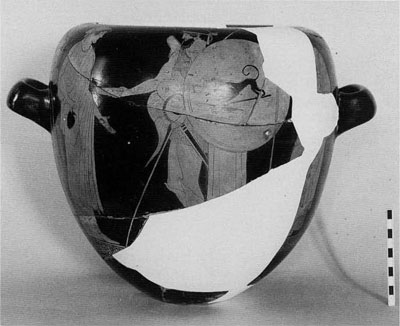
Museum Object Number: 48-30-3
The conservation and restoration of the red-figure stamnos 48-30-3 (University Museum collection) was undertaken with a view to returning the vase to a condition that best portrayed the original fragments, without deceit or undue restoration. The previous restoration, as noted by Ashmead and Phillips, had altered and added to the original so much that it was impossible to accurately comprehend the original nature and decoration of the vessel. The so-called substitution technique of restoration as used on this vessel was frequently practiced in the 19th century to restore a vase to an aesthetic completeness, regardless of the fact that the substituted fragments did not actually belong. Current conservation and restoration ethics aim at preserving the integrity of an object with as little intervention as possible, and stress that any treatment undertaken should not be damaging to the object, or permanent.
The treatment of the vase was begun by completely disassembling the previous restoration. Most of the adhesives and fill materials used in the late 19th and early 20th century do not age well and discolor and embrittle with time. In this instance the previous adhesive was an animal glue, and it was removed without endangering the ceramic by soaking the vessel in hot water. The fill material was also water-soluble and was brushed off. Some of the overpaint which had been applied (over the original clay and decoration) was considerably more stubborn, but could be removed with the proper choice of solvents on cotton swabs. In this manner, all the surfaces were cleaned of obscuring paint and brought back to their original (post-burial) condition.
After the removal of the previous restoration, the disassembled fragments had to be conserved, that is, cleaned and stabilized. The fragments were cleaned using a nonionic detergent and a soft brush, and were soaked in deionized water to remove any contaminating soluble salts that might have been introduced during burial and/or previous treatment. In order to present the fragments in a more stable and understandable context, all the pieces were assembled using an acrylic adhesive. This adhesive is a synthetic copolymer, well-known in conservation and tested and trusted as one of the most stable resins available. It is also easily removable or “reversible” in case there is ever any ned or desire to again redo the vessel.

Museum Object Number: 48-30-3
Once the fragments were assembled it was clear that the pieces were still not in a stable nor understandable (much less exhibitable) condition, and that some amount of restoration was desirable. Almost half of the vessel was missing, and the two major sections which were preserved did not actually join. After discussion with the curator of the Mediterranean Section, it was decided to join the two sections together and use plaster of paris to fill in the missing areas (Fig. 1). The rim and base were not to be reconstructed because no fragments existed. Where possible, the restored sections were made detachable and simply glued into place so that the restorations could be considered a separate entity. This manner of restoration provides a greater structual strength to the whole and also protects the original fragments from plaster contamination. Furthermore, because the adhesive is the same acrylic as that used to join the pieces, the entire treatment is easily reversible.
Once the reconstruction and plastering were finished, the plaster areas were inpainted so as not to detract from the visual appearance of the vase. This is also an issue which involves a delicate balance between ethics and aesthetics: glaring white plaster is very distracting, but too close a match in color or detail can be deceiving. At first it was decided to continue or “round off” the red-figure areas (notably figure 3, the man, on Side A) with a red-orange paint, but this interfered with the visual appearance of the original (Fig. 2). Therefore, all the plaster was painted a matte black, with the exception of the top and bottom borders of the panel and the warrior’s shield, which were painted a matte red-orange. The colors were chosen to approximate the red-figure background color and the ‘black glaze’ color. In this manner, the restoration can be easily discerned from the original, even in a black and white photograph.
The restored vase, though missing a rim and a base, presents an aesthetic compromise that is both pleasing and understandable to the professional art historian and lay person. Structurally, the vase is stable and in a suitable condition for exhibition.
